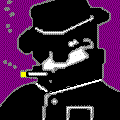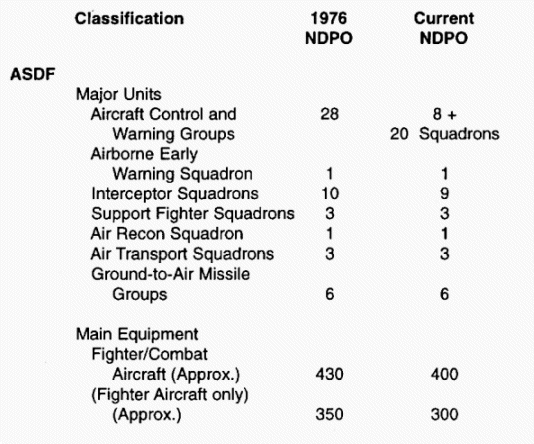





Japan has a long configuration from the north to the south with its population and industrial centers concentrated in particular regions. In addition, as the Japanese government maintains an exclusively defense-oriented policy, Japan is forced to take a passive position at the early stage of the air incursions in which invaders take the initiative. In order to defend the life and the property of the Japanese people from invading aircraft and missiles under Japan's geographical characteristics and defense-oriented policy, the Air Self-Defense Force should detect invading aircrafts and missiles as soon as possible and destroy them as far from Japan as possible. So the ASDF should have capability for vigilance and surveillance and for a quick counterattack to fight against invading aircrafts and missiles. The ASDF must possess aircraft control and warning units that consist of a network of radar sites and airborne early warning capable of vigilance and surveillance throughout the air space in and around Japan on a continuous basis, fighter units and ground-to-air missile units to take immediate and appropriate steps against violations of Japan's territorial airspace and air incursions, units capable of engaging in the interdiction of airborne or amphibious landing invasions and air-support for land forces as necessary, and units capable of effective operational supports including air reconnaissance, air transportation and other operations as necessary.
Major units of the ASDF are the Air Defense Command, Flight Support Command, Flying Training Command, Air Developing and Proving Command, and Air Mat�riel Command. The Flight Support Command is responsible for direct support of operational forces in rescue, transportation, control, weather monitoring, and inspection. The Flying Training Command is responsible for basic flying and technical training. The Air Developing and Proving Command, in addition to overseeing equipment research and development, is also responsible for research and development in such areas as flight medicine. The Air Defense Command has northern, central, and western regional headquarters located at Misawa, Iruma, and Kasuga, respectively, and the Southwestern Composite Air Division based at Naha on Okinawa. All four regional headquarters control surface-to-air missile units of both the ASDF and the GSDF located in their respective areas.
The ASDF maintains an integrated network of radar installations and air defense direction centers throughout the country known as the Basic Air Defense Ground Environment. In the late 1980s, the system was modernized and augmented with E-2C airborne earlywarning aircraft.
The nation relies on fighter-interceptor aircraft and surface-to -air missiles to intercept hostile aircraft. Both of these systems were improved beginning in the late 1980s. Outmoded aircraft were being replaced in the early 1990s with more sophisticated models, and Nike-J missiles were being replaced with new Patriot systems. Essentially, however, the nation relies on United States forces to provide interceptor capability.
The ASDF also provides air support for ground and sea operations of the GSDF and the MSDF and air defense for bases of all the forces. Although support fighter squadrons started being modernized in 1989, they lack precision-guided weapons for support of ground operations and attacks on hostile ships, and ASDF pilots receive little flight training over oceans to prepare for maritime operations. The ASDF has an inadequate poor base defense capability, consisting mainly of outmoded antiaircraft guns and portable shelters to house aircraft. Base defenses were being upgraded in the late 1980s with new surface-to-air missiles, modern antiaircraft artillery, and new fixed and mobile aircraft shelters.
The Air Self-Defense Force (ASDF) is the major aviation arm of the SDF. It had an authorized strength of 47,000 and maintained some 46,000 personnel and approximately 330 combat aircraft in 1992. Front-line formations include three ground-attack squadrons, nine fighter squadrons, one reconnaissance squadron, and five transport squadrons.
The National Defense Program Outline which determines Japan's defense capabilities, was reviewed and newly established in December 1995. Aircraft Warning and Control system will be made more efficient and functional: for instance, as regards the aircraft warning and control units at radar sites throughout the country, 20 aircraft control and warning groups out of 28 shall be reorganized into the warning squadrons while the AWACS aircraft shall be introduced. One squadron of the fighter units shall be disbanded, with the remaining 12 fighter squadrons forming a more efficient and flexible system.

Under the new Outline, however, the ASDF will reorganize 20 of the 28 early-warning groups into smaller early-warning squadrons by enhancing the efficiency of control and warning mission considering the introduction of AWACS (airborne warning and control system) aircraft. Thus the ASDF will now possess eight early-warning groups and 20 early-warning squadrons. In addition, one squadron of airborne early-warning aircraft will be maintained in order to supplement the limited capability of fixed ground radar against aircraft intruding at low altitude, and to maintain early-warning capabilities over ocean areas remote from the mainland.
Under the previous Outline, the ASDF has possessed 13 fighter squadrons in order to maintain constant and continuous capability for scrambles and other appropriate responses against violations of territorial airspace and air incursions, in conformity to Japan's geographical characteristics. This posture was based on the idea that, while a total of 14 fighter squadrons -- two each in seven districts throughout the nation -- are needed, one squadron larger in size than other squadrons can be assigned to the district over Southwestern Islands.
In view of recent changes in the international military situation, however, partial reductions in the posture of the ASDF is considered to be possible. Accordingly, under the new structure, the ASDF will reduce one fighter squadron and possess a total of 12 fighter squadrons.The 12 fighter squadrons consist of nine interceptor units and three support fighter units. The main mission of interceptor units is to intercept intruding aircraft, while that of support fighter units is to counter landing invasions, and to support from the air the GSDF and MSDF units fighting against invading forces as necessary.
The ground-to-air missile units of the ASDF counter air invasion together with the fighter squadrons. The ASDF will maintain six ground-to-air missile groups for the air defense of each area of political, economic and strategic importance _ central part of Hokkaido, area around Tsugaru Strait, Kanto district, Keihanshin district, northern part of Kyushu, and Okinawa. The ASDF must possess air reconnaissance and air transport units in order to provide effective support for air operations through air reconnaissance and air transport operations as necessary. The ASDF will maintain one air reconnaissance squadron to engage in air reconnaissance in case of aggression and other eventualities. At the same time, the ASDF will continue to possess three air transport squadrons to support mobile operations of fighter units and parachute operations of airborne units, as necessary, and to engage in transportation between main bases in peacetime. Combat aircraft are the main equipment of the ASDF. About 430 combat aircraft were to be possessed under the previous Outline, but following the changes in the structure of the ASDF as mentioned so far, the number of combat aircraft will be reduced to about 400. The number of interceptors will be reduced to about 300 from about 350. The Defense Agency has been seeking to introduce in-flight refueling aircraft. In December 1999, the Security Council of Japan (SCJ) recommended that Japan introduce air tankers without delay in the next defense plan. The agency will therefore work out details about when and how many to introduce.After passing an entrance examination, recruits can enter several training programs. Lower-secondary school graduates are eligible to enter the MSDF's four-year youth cadet program to earn upper-secondary school equivalency and NCO status, or they can undergo twelve-week recruit training courses followed by technical training lasting from five to fifty weeks. Upper-secondary school graduates can also enter either two-year NCO or four-year flight courses. Specialized training is available for all NCOs, as are opportunities to enroll in officer and flight officer candidate courses. Graduates of the four-year National Defense Academy or four-year universities receive thirty to forty weeks of instruction in officer candidate schools. Advanced technical, flight, and command staff officer programs are available for officers.
